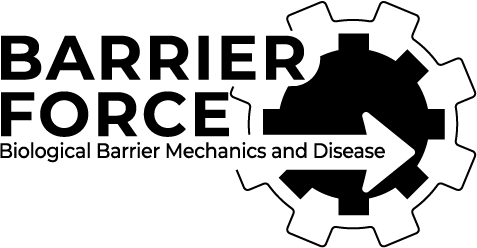Publications
Highlighted publications from CoE
-
Piezo1 balances membrane and cortex tension to stabilize intercellular junctions and maintain the epithelial barrier
Formation of the skin barrier is essential for organismal survival and tissue homeostasis. Barrier formation requires positioning of functional tight junctions (TJs) to the most suprabasal viable layer of the epidermis through a mechanical circuit that is driven by generation of high tension at adherens junctions. However, what allows the sensing of tension build-up at…
-
2-hydroxyglutarate mediates whitening of brown adipocytes coupled to nuclear softening upon mitochondrial dysfunction
Mitochondria have a crucial role in regulating cellular homeostasis in response to intrinsic and extrinsic cues by changing cellular metabolism to meet these challenges. However, the molecular underpinnings of this regulation and the complete spectrum of these physiological outcomes remain largely unexplored. In this study, we elucidate the mechanisms driving the whitening phenotype in brown…
-
Integrin β1 activity controls colony morphology during human pluripotent stem cell state transitions
Integrin β1-mediated adhesion is dispensable in early mouse embryogenesis (pre-implantation) but indispensable post-implantation, suggesting distinct roles for β1-integrin-mediated adhesions in the naive (pre-implantation) versus primed (post-implantation) pluripotent stem cells (PSCs). We investigated the role of integrin β1 in regulating naive-like and primed human induced PSC (hiPSC) states. We find that integrin β1 is active in…
-
EPLINα controls integrin recycling from Rab21 endosomes to drive breast cancer cell migration
Epithelial protein lost in neoplasm (EPLIN), an actin-binding protein, has been described as both a tumor promoter and tumor suppressor in different cancers. The roles of EPLIN isoforms (α/β) remain largely unknown and could explain these opposing views. We observed distinct EPLIN isoform localization in breast cancer cells; EPLINα is recruited to actin in plasma…
-
Dynamic cytoskeletal regulation of cell shape supports resilience of lymphatic endothelium
Lymphatic capillaries continuously take up interstitial fluid and adapt to resulting changes in vessel calibre1-3. The mechanisms by which the permeable monolayer of loosely connected lymphatic endothelial cells (LECs)4 maintains mechanical stability remain elusive. Here we identify dynamic cytoskeletal regulation of LEC shape, induced by isotropic stretch, as crucial for the integrity and function of…
-
Dynamic regulation of integrin β1phosphorylation supports invasion of breastcancer cells
Integrins provide an essential bridge between cancer cells and the extracellular matrix, playing a central role in every stage of disease progression. Despite the recognized importance of integrin phosphorylation in several biological processes, the regulatory mechanisms and their relevance remained elusive. Here we engineer a fluorescence resonance energy transfer biosensor for integrin β1 phosphorylation, screening…
-
Sphingolipid metabolism orchestrates establishment of the hair follicle stem cell compartment
Sphingolipids serve as building blocks of membranes to ensure subcellular compartmentalization and facilitate intercellular communication. How cell type-specific lipid compositions are achieved and what is their functional significance in tissue morphogenesis and maintenance has remained unclear. Here, we identify a stem cell-specific role for ceramide synthase 4 (CerS4) in orchestrating fate decisions in skin epidermis.…
-
Measuring and manipulating mechanical forces during development
Tissue deformations are a central feature of development, from early embryogenesis, growth and building the body plan to the establishment of functional organs. These deformations often result from active contractile forces generated by cells and cell collectives, and are mediated by changes in their mechanical properties. Mechanical forces drive the formation of functional organ architectures,…
-
The role and regulation of integrins in cell migration and invasion
Integrin receptors are the main molecular link between cells and the extracellular matrix (ECM) as well as mediating cell-cell interactions. Integrin-ECM binding triggers the formation of heterogeneous multi-protein assemblies termed integrin adhesion complexes (IACs) that enable integrins to transform extracellular cues into intracellular signals that affect many cellular processes, especially cell motility. Cell migration is…
